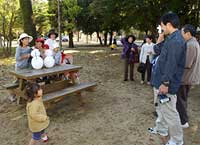|
|
|||||||
|
|
|||||||
|
|||||||
| | Web Japan >> | Trends in Japan >> | Business & Economy >> | On Location | |
|
ON LOCATION Tourists Flock to Places Featured in Hit Movies (January 20, 2005) A new breed of tourist is beginning to attract the attention of tour operators and of localities where movies have been filmed. The main objective of these visitors is not to see famous landmarks or to go shopping but to visit the settings of popular movies and TV series. They are eager to experience for themselves the atmosphere portrayed in their favorite movies or TV shows. Spend a Night at the Hotel in the Movie After its release, a group of travel organizations, including the Japan National Tourist Organization, invited a group of American and British journalists on an excursion showing off some of Tokyo's charms, including some of the settings from Lost in Translation. Seven Japanese travel companies, including JTB Corp., then got in on the act by concocting a tour aimed at tourists from the United States that takes in some of the Lost in Translation spots. Among the locations featured in the film is the Park Hyatt Tokyo hotel, where the main characters are shown staying and where tour members also get to stay. The visitors dine in the same restaurant as featured in the movie, where they can also enjoy the same spectacular nighttime view of Tokyo as the main characters did. With a view to tapping this trend for movie-inspired tourism, a venture company has been set up which handles everything from inviting film crews to shoot in Japan to planning sightseeing tours of movie locations. The company was the major force behind the South Korean movie Blue Swalllow, shot in the Japanese hot-spring resort town of Atami in Shizuoka Prefecture. Due for release in 2005, the movie recounts the life of Korea's first female pilot, who died in Atami. The firm banded together with several major companies in a campaign to attract South Korean tourists to visit the movie's breath-taking setting, where huge cliffs and rocks seem to plunge into the sea. Japan was also the setting of a recent South Korean TV drama series. The show was filmed in March 2004 in the town of Shintoku, on the northern island of Hokkaido, and featured some of South Korea's best-known actors. The town government and local tourist organization now plan to advertise the local resort facilities featured in the show to attract sightseeing tours from South Korea. Tours which have already proved popular elsewhere in Japan include trips to the locations featured in the best-selling novel Sekai no Chushin de, Ai o Sakebu (Crying for Love at the Heart of the World) and the hit movie Ima, Ai ni Yukimasu (I'm coming to See You Now). A New Form of Cultural Exchange In Japan, many local governments have established film commissions, which advertise the benefits of their respective regions to filmmakers. There are already more than 60 such bodies operating in Japan. Some have produced web pages in English and Korean in the hope of attracting movies from outside Japan. The competition over film locations - and tourist spending - continues to heat up. Copyright (c) 2005 Web Japan. Edited by Japan Echo Inc. based on domestic Japanese news sources. Articles presented here are offered for reference purposes and do not necessarily represent the policy or views of the Japanese Government. |
HAPPY BIRTHDAY ASTRO BOY! (April 21, 2003) THE RING (January 9, 2003) |
|
|



